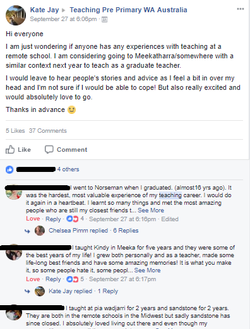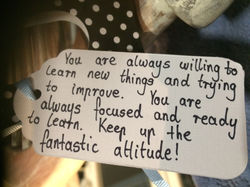Reflective commentary
Effective administration, record management, documented policies and procedures are essential in a school environment where delivering quality education and care for children is the primary focus (ACECQA, 2017). I ensured I was always professional and followed school policies such as ensuring children had hats on outdoors at all times, ensured I was never alone with children, conducted frequent head counts and alerted a staff member to any serious injury. I also ensured I aligned with the code of conduct and ethics for teaching, ensuring learning, excellence, equity and care was at the forefront of all my actions during the practicum (Department of Education, 2011).
Establishing partnerships with the community and families has strong benefits for students, families and teachers as well as the broader school and community (Groundwater-Smith et al, 2011). There is a positive correlation between school-family partnerships and retention rates, social skills, educational outcomes and enhanced wellbeing (Groundwater-Smith et al, 2011). Maintaining confidentiality is an indicator of the school’s professionalism and builds families’ confidence in them (ACECQA, 2017). Groundwater-Smith et al (2011) remind us that families are children’s first teachers and continue to influence their children’s learning and development throughout their lives and emphasise the importance of having a genuine desire to build partnerships with families and communities. They explain the requirement of positive interpersonal skills including active listening, smiling and being welcoming. As a result, I endeavoured to find a variety of ways to include parents in their child’s education and ensured I was always friendly and welcoming.
Additionally, I am always actively involved in teaching networks on social media and through attending professional development opportunities. This enables me to ask for advice and stay abreast of current issues and events relating to teaching in the early years. I am continually seeking opportunities for professional learning and events that enable me to network with other teachers and have signed up for Network Teach which provides free or low-cost PL of which I have attended several.
Action plan
-
Have organised with my mentor to attend open night to provide further opportunity and practice interacting with parents and organising such an event
-
Currently undertaking a certificate 3 in Community Services to support me to support my ability to develop relationships with families and the broader community
-
I plan to volunteer across schools to broaden my opportunities to network with other teachers and principals
-
I have organised with my mentor to read through the school documents to get a larger feel for the policies, procedures and aims of the school
-
I plan to find out more about the legislative and ethical requirements of teaching for example by studying the code of ethics located at http://www.det.wa.edu.au/policies/detcms/policy-planning-and-accountability/policies-framework/guidelines/code-of-conduct1.en?cat-id=3457094
Outcome
The experience highlighted the importance of a solid support network as a teacher and the benefits that arise from sharing planning, resources and advice. I received positive feedback from my mentor and fellow pre-primary teacher regarding my professionalism and ability to develop relationships with staff and families.
Throughout the duration of the term I received many compliments from parents regarding my teaching and the positive things children have been sharing with them at home about my lessons. I had a parent who is also a primary teacher approach me and inform me that I have been doing some great, hands-on activities which suits the learning style of her child and told me that her daughter has loved all the things we have been doing in class and that parents. I also received feedback from a parent regarding my behaviour management system and that her daughter has been talking about it and home and has been “trying really hard”. I also received lovely gifts from the parents and a card from the parents signed by the children at the end of my placement.
Situation
I undertook my final ten-week practicum in a pre-primary class. As I was in the early childhood block with a kindergarten, another pre-primary class and two year one classes, I developed strong relationships with the other pre-primary teacher in particular as well as a good rapport with the other teachers. I developed a great relationship with the Kindergarten teacher and we would often discuss our planning and she would offer great advice. I was also fortunate to have 3 fellow pre-service teachers in those classes. We developed good friendships during my time there and were able to discuss our planning, reflections, successes and failures. The school held weekly meetings on a Wednesday alternating between an early years (phase) meeting and a whole-school meeting which I always attended.
Action
In addition to the fantastic professional network I developed at the school, I also developed a rapport with many of the children’s families. Initially, I created a parent introduction letter which was put on the classroom door and remained there all term. I also ensured I greeted parents daily and initiated conversation with them or shared things about their child at the end of the day. I sent home an ‘About Me’ page for parents and children to fill in which gave me a better understanding of children and their families as well as children’s interests to incorporate into my teaching. Groundwater-Smith et al (2012) recommends sending a questionnaire asking families to share their knowing about their child. We also had parent helpers in several days a week which enabled me to get to know family members better and I was able to involve them in the classroom. I also had a parent who was very musically inclined and I invited him to come during a music session, where he offered to play the didgeridoo for us to accompany our learning about Aboriginal People. I then arranged for this visit and restructured the daily timetable to enable this to occur.
I found ways to involve parents in the learning process by writing notes on the outdoor whiteboard about what we were learning in class and asking them to bring in things related the topic. For example, when learning about shapes I put out a note asking parents to bring in any shapes that they find around the home. This received a fantastic response and the children were bringing in all kinds of shapes which they absolutely loved. They also told me about the fantastic conversations they had with parents trying to figure out which 3D shape they were. I also wrote up and sent home some learning stories and had a section for parents to comment on the learning story. I also created a “floor book” where I wrote about all the things we have learned over the term accompanied by photos. I then reflected on each topic with the children and wrote down some of the comments they had about it. I wrote up a description of the things we did and linked it to the curriculum and the EYLF for parents to see. I also encouraged parents to add any comments they had to the floor book. I also sent home a newsletter to families at the end of the term thanking them and outlining the learning that took place over the term. Finally, my gift to the children at the end of my placement was a little gift bag with a push point pencil, individualised eraser, a chocolate and a note with individual comments to each of the children; this was as much for the children as the parents and I received lovely feedback from the parents when I returned for Open night.
Evidence
 |  |
|---|---|
 |  |
 |  |
 |  |
 |  |
 |  |
 |  |

References
Australian Children’s Education & Care Quality Authority [ACECQA]. (2017). Guide to the National Quality Standard. Retrieved from http://files.acecqa.gov.au/files/National-Quality-Framework-Resources-Kit/NQF-Resource-03-Guide-to-NQS.pdf.
Department of Education (2011). Code of Conduct. Retrieved from http://det.wa.edu.au/policies/detcms/policy-planning-and-accountability/policies-framework/guidelines/code-of-conduct1.en?cat-id=3457094
Groundwater-Smith, S., Ewing, R. & Le Cornu, R. (2011). Teaching Challenges and Dilemmas. (4th ed). Melbourne, Australia: Cengage Learning Australia.

